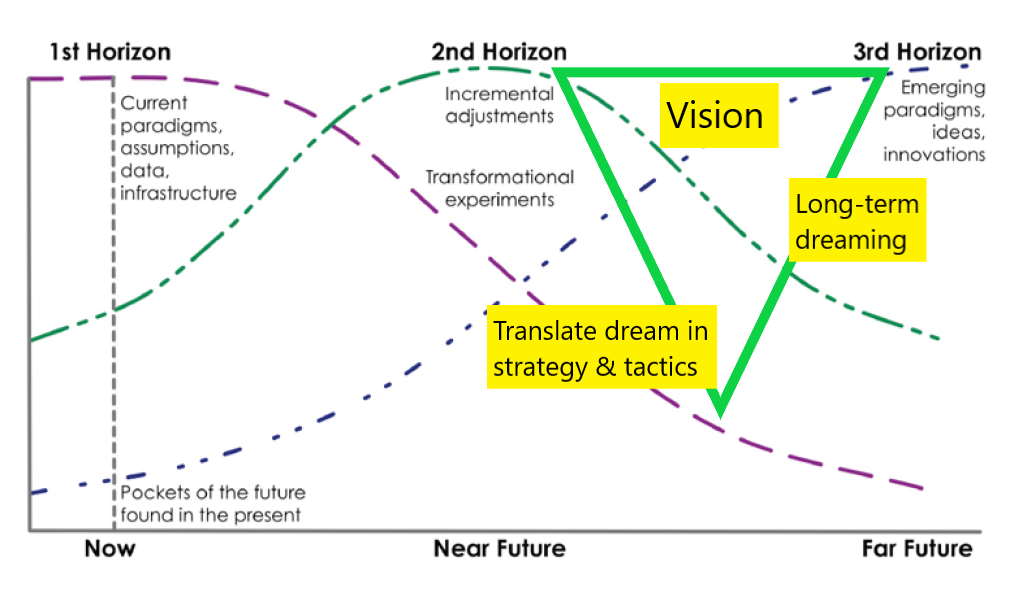Introduction
One week ago (28th July) we published the second article in a series of eight about Change Management and the consequences for IT projects. It focused in-depth on forming a Powerful Guiding Coalition. Applying some models tools as the Six Thinking Hats will enable a much higher chance of success in your projects. Thus set properly the tone at the top, have a colorful Guiding Coalition and Project Team(s) so that you mobilize enough power to drive change!
The experience from many different sources tells us that 75% of System Implementations fail to deliver their expected benefits. The one constant factor is that Change Management for People, Process and Technology is not appropriately addressed. Business leaders often do not realize enough how important this is or don´t know how to achieve it. Simply stated, but not so easily done.
This week we will look at step 3 (out of 8) of the model of Kotter: Creating a Vision.
You are encouraged to read further if you want to ensure your project ends up in the 25% quadrant.
The model of John Kotter for Change Management
This model was introduced by John P. Kotter, leadership and change management professor at Harvard Business School, in his 1995/2012 book, “Leading Change”. The model defines 8 key steps for change management, arguing that skipping any of the steps can be enough for the whole project to fail. Below we will go through step 3 of the model and show what it means for IT projects.
- Establishing a sense of urgency
- Forming a powerful guiding coalition
- Creating a vision
- Actions needed
- Creating a vision
- Develop strategies on how to implement the vision
- Pitfalls
- A vision too complicated or too vague
- Vision cannot be communicated in five minutes
- Consequences for IT projects
- Your IT strategy should be aligned with your business strategy and ultimately integrated. Without an IT strategy, no impactful and contributing project can be done. Last but not least, the IT strategy must be feasible
- Your IT strategy should be regularly updated, see step 1
- Actions needed
What is important here is that Senior Management is aware that every project or program (a group of related projects) is properly supported by a clear vision. A project that is linked to a clear vision positions well its place in the company and explains the reasons why people should work on it. The vision is, in fact, your compass.
If you have a sensible vision, your people are given direction and have a compass for making decisions. You empower them and in this way, Senior Management does not need to be involved in every decision.
Creating a vision
In a successful transformation effort, the guiding coalition develops a picture of the future that is relatively easy to communicate and appeals to relevant stakeholders and employees. According to Kotter, a vision always goes beyond the numbers that are typically found in multi-year plans. “A vision says something that helps clarify the direction in which an organization needs to move”.
“When the most common error is made, not creating a sensible vision, a transformation effort can easily dissolve into a list of confusing and incompatible projects that can take the organization in the wrong direction or nowhere at all”.
Kotter advises using a rule of thumb: “If you can’t communicate the vision to someone in five minutes or less and get a reaction that signifies both understanding and interest, you are not yet done with this phase of the transformation process”.
Creating a vision is often a difficult and lengthy process. This is for multiple reasons:
- It is not something that can be done “First Time Right”, it requires many iterations before a good enough version is created.
- It requires input from many people within the Guiding Coalition but most probably also from elsewhere in the organization.
- It requires thinking beyond the direct interests of the people within the Guiding Coalition. In other words, it requires teamwork at the highest level.
- It requires both analytical thinking and dreaming about possibilities in the future within a group of people. For this reason, the personality types within the Guiding Coalition must be complementary and diverse.
- It must be possible to communicate the vision in a few minutes, otherwise, it will not land well within the organization. People should be able to easily understand the vision, embrace it, and even be proud of it.
For the reasons mentioned above, it is of utmost importance to create enough Sense of Urgency first and be very careful in creating the powerful Guiding Coalition. Otherwise, the appropriate vision will never materialize.
Next to that, a practical way of working needs to be in place to move towards creating the vision. Discipline and persistence are key here.
Methods & Tools
In part 1 of these series of 8, we referred to the model of the Three Horizons of Sharpe & Hodgson. For creating a vision, the thinking needs to be about future possibilities (which is the third horizon) in conjunction with giving direction and applicability (which is the second horizon).
The second horizon (green line) calls for an entrepreneurial way of thinking. Exploring the second horizon means thinking in innovations that will replace the current way of working. These innovations enable the Business and IT transformation and support the company towards the next maturity phase. The vision here helps to clarify in what direction a company should move forward. Innovations can be endless if the vision is not clearly set. In the second horizon, you translate your dream into a clear strategy and tactics.
For defining the long term vision you make use of horizon 3. This horizon is the visionary way of thinking, the dreaming. An appropriate vision may show its value for years, especially when it is on the company level. But for an IT project, horizon 3 might be too much looking forward. So you will need to tune the amount of forward-looking, depending on the magnitude, impact, and positioning of your project in the company. In the graph below this is further visualized:
Consequences for IT projects
As stated in the previous article (“Forming a Powerful Guiding Coalition”), IT projects are often underestimated because Business Leaders do not realize enough how integrated People, Process and Technology are. A successful IT project always requires Change Management for all three.
IT projects must be linked to the vision and accompanied by a strategy to get the IT projects implemented. People have to well understand why an IT project fits in the vision and to what the IT project will lead. Only then they will be sufficiently motivated and empowered to take decisions. This way they can make changes in the processes and embrace new ways of working enabled via new technologies.
Without alignment between People, Process and Technology, it is almost certain that you will not be in the 25% of successful projects.
Conclusion
Not creating a clear vision will create confusion in your organization about your IT projects and can lead the company in the wrong direction. Creating a clear vision helps to position your IT projects from the right perspective. It empowers and motivates your people to make changes in processes and embrace new technologies.
Did you realize all this when you started your last IT project? Proper Change Management is key for successful IT projects! If you want more information or you have specific questions, you can book a free consulting session on our website: www.Q7-consulting.com

